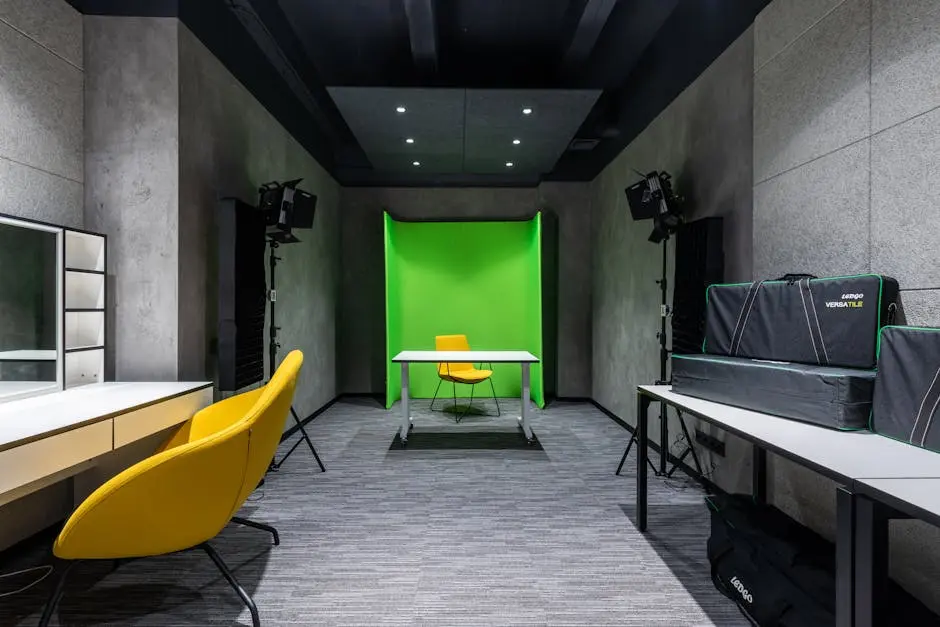In the fast-paced world of modern media, broadcasting studios are the lifeblood of creative content production. To keep up with the demand for quality output, studios need to integrate cutting-edge technology and innovative features. Whether you’re setting up a new studio or upgrading an existing one, here are the essential features that can transform your broadcasting space into a high-tech haven.
1. State-of-the-Art Audio and Video Equipment
To produce high-quality broadcasts, invest in the latest audio and video equipment. This includes high-definition cameras, premium microphones, and cutting-edge audio mixers, ensuring crystal-clear sound and visuals. A well-equipped studio sets the foundation for top-notch production, allowing broadcasters to deliver engaging content to their audiences. High-definition cameras capture every detail, bringing the action to life, while premium microphones ensure that every word is heard loud and clear. These tools are essential for maintaining high standards in any broadcasting operation, aligning with current industry expectations.
Investing in advanced video processing technology will further enrich your studio’s capabilities. Devices like video switchers and digital video servers offer seamless transitions and support the inclusion of real-time graphics, making your broadcasts more dynamic and visually appealing. The importance of having reliable and high-quality equipment cannot be overstated, as it directly impacts the viewer’s experience and helps maintain a professional broadcast image.
2. Advanced Lighting Systems
Proper lighting is crucial for any studio. A high-tech setup should include LED lighting systems that offer customizable options to create perfect ambient conditions for different types of broadcasts. These systems allow for a range of temperatures and intensities, which are essential for setting the mood and enhancing the visual appeal of your content. Efficient lighting not only brings clarity to the subjects but also highlights important on-screen elements, helping to guide the audience’s attention.
Implementing smart lighting technology can automate lighting adjustments, making it easier for the production team to maintain consistency across different segments and broadcasts. With automated control systems, studios can efficiently shift lighting scenarios to match the mood of each broadcast, whether it be a lively talk show or a somber news segment. This flexibility in lighting design elevates the quality of your productions and creates a more polished and professional look, contributing to higher audience retention.
3. Versatile Set Design
Modular and flexible set designs allow you to adapt your studio for different shows effortlessly. This versatility can save both time and resources while maintaining an engaging visual presentation. Modern sets often incorporate elements like movable walls and interchangeable backgrounds, which provide endless possibilities for altering the studio’s appearance according to specific show requirements.
Incorporating virtual sets into your studio design expands creative boundaries even further. Virtual production techniques have the power to transport viewers into expansive, imaginative worlds without leaving the confines of the studio. By using technologies like augmented reality, you can create immersive and interactive settings that captivate audiences and enhance the storytelling experience. The adaptability of virtual sets ensures that your studio can keep up with the fast-paced demands of modern broadcasting, offering a visually appealing alternative to traditional set design.
4. Robust Streaming Capabilities
As live streaming becomes more prevalent, a broadcasting studio must be equipped with reliable internet connections and streaming software to ensure smooth, uninterrupted live broadcasts. Robust streaming infrastructure is vital for catering to the growing demand for live content and engaging with audiences in real-time. Implementing high-speed internet services, robust routers, and backup systems ensure that streams remain consistent and buffer-free, keeping audience engagement high.
To optimize streaming quality, studios can utilize advanced encoding solutions that compress data without sacrificing video and audio quality. By doing so, broadcasting studios can deliver high-definition streams even with bandwidth constraints. In addition, platforms that support multi-platform streaming enable studios to reach broader audiences by broadcasting simultaneously across different social media and digital channels. Remote production also plays a role, allowing staff to manage streams from any location, further enhancing flexibility.
5. Cutting-Edge Editing Software
Invest in advanced editing software that offers comprehensive tools for post-production. This will enhance the final output and help streamline the editing process. Modern editing platforms, such as Adobe Premiere Pro or Final Cut Pro, provide features like seamless integration with cloud services, allowing for collaborative work and easy access to footage from anywhere.
Incorporate software solutions that support multi-layer editing and real-time previews to expedite the editing workflow. These tools are equipped with user-friendly interfaces designed for both seasoned editors and newcomers, making it easier to produce content efficiently. By utilizing AI-powered features, editors can automate tedious tasks like color correction and audio balancing, enabling more focus on creative elements.
6. Soundproofing and Acoustic Treatment
Soundproofing and proper acoustic treatment are essential for minimizing noise interference and optimizing sound quality, creating a professional broadcast environment. Techniques such as installing acoustic panels and bass traps help manage sound reflections and eliminate echo, providing a clean audio experience that is critical for maintaining viewer attention and ensuring clear communication.
Beyond traditional methods, consider incorporating smart acoustic solutions, like digitally controlled sound-shaping technologies, which adapt to different sound environments for optimal audio performance. These smart solutions can automatically calibrate sound settings to match the requirements of specific recording segments, offering more refined control over the studio’s acoustic environment. This level of detail in sound management is indispensable for delivering professional-grade broadcasts consistently.
7. Remote Collaboration Tools
In today’s global workplace, remote collaboration tools are indispensable. Equip your studio with tools that allow team members to work together seamlessly from different locations. Platforms like Slack, Trello, and Zoom have changed how teams interact, enabling constant communication and coordination, irrespective of physical distance.
Integrating cloud-based project management software can facilitate real-time collaboration and file sharing among teams, further enhancing productivity. With these tools, team members can access and edit documents simultaneously, manage production timelines, and track project progress from anywhere. This connectivity allows for dynamic responses to changes in real-time, ensuring that all aspects of production remain on schedule and align with the overall creative vision.
8. Cutting-Edge Teleprompters
A top-notch teleprompter system that integrates with your broadcast software can make a significant difference, helping presenters deliver content smoothly and confidently. These systems support a range of features, including remote control, script editing, and speed adjustment to suit the presenter’s pace.
Advanced teleprompters can now include voice-controlled interfaces and eye-tracking technology that adjusts text scroll speed automatically. This not only provides ease of use but also enhances the on-screen presence of presenters by allowing them to focus on engaging the audience without distraction. With these smart additions, presenters can maintain a natural delivery style, which is paramount for retaining viewer interest.
9. Multipurpose Control Rooms
An efficient control room setup is vital in managing broadcasts effectively. Incorporate cutting-edge control panels and monitoring systems for real-time adjustments. This operational core of a studio allows for seamless coordination and synchronization of various production elements, from camera feeds to audio levels.
Adopting modular design in control rooms provides the flexibility to customize the space according to current and future production needs. Control desks with adjustable configurations and ergonomic designs enhance operator comfort and efficiency, minimizing fatigue during long broadcasts. Such multipurpose setups prepare studios for various broadcast formats, whether it’s a live news program or a complex, multi-camera production.
10. Energy Efficiency and Sustainability
Incorporate energy-efficient practices and sustainable equipment to reduce operational costs and environmental impact. This forward-thinking approach is increasingly important in modern studio design. Upgrading to LED lighting, energy-efficient HVAC systems, and eco-friendly set materials are some of the ways studios are embracing sustainability.
In addition to the immediate cost savings, sustainable practices can enhance a studio’s marketability by aligning with the growing consumer demand for eco-conscious businesses. Installing solar panels or wind energy solutions can further decrease carbon footprint. Implementing a green strategy in your studio is not just environmentally responsible, but it also promotes a positive brand image and complies with emerging environmental regulations.


